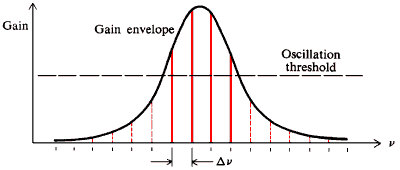![[ Cavity Spectral Rsponse Plot ]](fpairy.gif)
![[ Laser Resonator Diagram ]](fpdevice.gif)
The gain of a lasing medium can be enhanced by placing it between
a pair mirrors to increase the effective lenght and restrict the allowed
spatial and spectral modes of operation, greatly improving coherence
and reducing pumping power requirements. This optical configuration is
similar to the Fabry Perot cavity, and is the most common laser interferometer.
From quantum mechanics we know that the photon is both a particle and a wave, the geometrical optic description of the Fabry-Perot cavity is related to the particle viewpoint, while the description of the cavity in terms of diffraction is based on the wave nature of light.
If the lasing medium is contained within a Fabry-Perot type of resonant cavity, then above a well defined intensity threshold where gain exceed losses almost all of the excited ions decay prematurely by stimulated emission. This cascade contributes to a macroscopic electromagnetic cavity mode or quantum wavefunction consisting of an enormously intensified copy of the original first few spontaneous emissions that sparked the initial cascade. This regime is called laser ocilllation, as opposed to laser amplification below threshold.
![[ Cavity Spectral Rsponse Plot ]](fpairy.gif)
The spectral response of the cavity, where R is cavity reflectivity.

Plot of laser gain as a function of frequency. The natural gain bandwidth (black curve) is further restricted to dicrete cavity modes (red), of which only four are above the laser oscillation threshold.
![[ Diagram of electric field distribution of resonant modes ]](fpmodes.gif) Electric field distribution of a few of the lowest order resonant modes
of a cylindrical cavity. Up or down arrows
(
red or
blue regions) indicate
the phase of the electric field and arrow length indicates relative
strenght.
Electric field distribution of a few of the lowest order resonant modes
of a cylindrical cavity. Up or down arrows
(
red or
blue regions) indicate
the phase of the electric field and arrow length indicates relative
strenght.
![[ 'Hall of Mirrors' effect on light in a cavity. ]](fpvirtual.gif)
'Hall of Mirrors' effect on radiation reflecting back and forth between the two mirrors of a high reflectivity laser cavity.
![[ Effect of diffraction in selecting resonant modes ]](fpdiffraction.gif)
Effect of diffraction in selecting resonant modes.
If the lasing medium is contained within an optical cavity the repeated passes of the stimulated emission output can enhance the gain sufficiently to create a macroscopic electromagnetic mode which can build up to produce a highly coherent, narrow output beam of extreme monochromaticity : The spectral width of the emission line can narrow by four orders of magnitude over spontaneous fluorescence or amplified spontaneous emission. In this regime of operation, a strange oscillatory behavior of the output pulse can be observed, which is attributable to an accelerated rate of stimulated emission which drives the inverted population below threshold, the lasing medium then requires a certain recovery period for the populations to build up above the threshold once again.
If the ions are placed within a cavity, the gain can be significantly improved to the point where the output beam becomes coherent, extremely narrow and of significantly reduced spectral width, essentially producing a single resonant mode of electromagnetic radiation.
The cavity is used not only to maintain a large enough electromagnetic field strength to stimulate emission from excited ions but also to maintain feedback and thus coherence of the output beam.
The optical cavity serves to